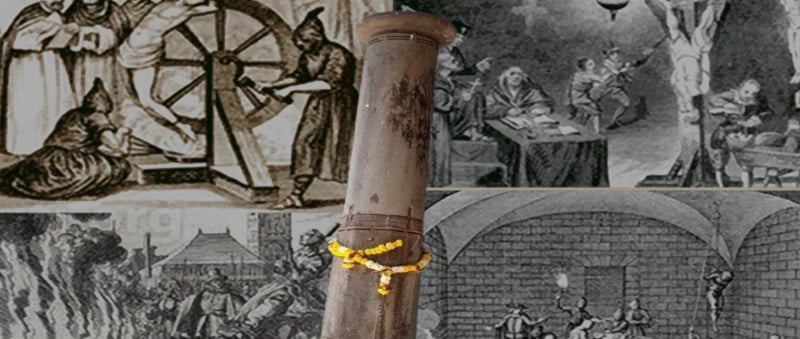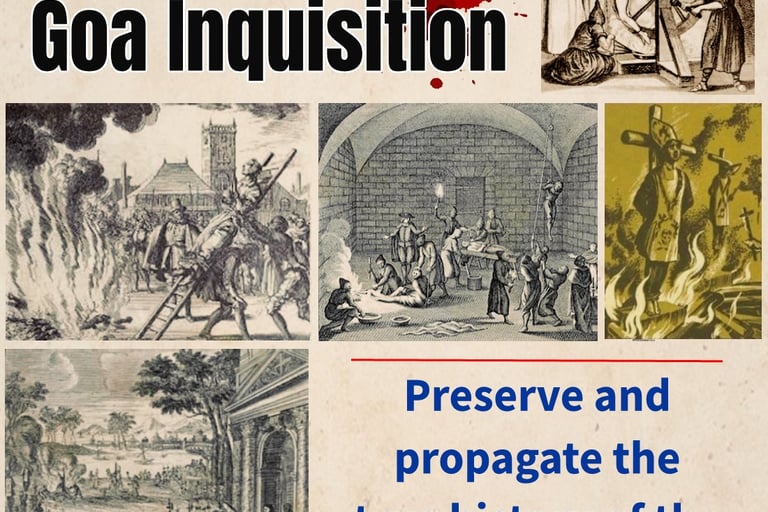"Goa Inquisition: The Forgotten Hindu Genocide & Forced Conversions by Portuguese Colonizers"
The Portuguese Inquisitors and Jesuit priests devised gruesome punishments for Hindu women who refused to convert to Christianity. One of the most barbaric tortures was the mutilation of breasts.
HISTORY
2/21/20254 min read


Goa Inquisition: The Forgotten Hindu Genocide by Portuguese Colonizers
The Goa Inquisition remains one of the most brutal, yet deliberately hidden, episodes of religious persecution in Indian history. What is falsely portrayed in textbooks as a "civilizing mission" of European explorers was, in reality, a ruthless genocide of Hindus, orchestrated by the Portuguese and the Catholic Church.
The crimes committed under St. Francis Xavier and the Portuguese rulers were nothing short of barbaric—temples were destroyed, Hindu men, women, and children were massacred or forcibly converted, and any practice of Hinduism was outlawed. The horror of the Goa Inquisition, spanning from 1560 to 1812, is a story of cultural destruction, mass murder, and forced religious dominance that needs to be told in its entirety.
Francis Xavier: The Man Behind the Massacre
Francis Xavier, often glorified as a saint, was the prime architect behind the religious cleansing of Hindus in Goa. After arriving in Goa in 1542, he was horrified to see Hindus practicing their religion and actively lobbied the King of Portugal to introduce the Inquisition. In his own letters, Xavier wrote:
"When I first came to these countries, I could not bear to see them worshiping their false gods. I went to the King of Portugal and informed him that if he did not act quickly, the devil would take these lands."
This appeal led to the establishment of the Goa Inquisition in 1560, one of the most feared religious courts in history.
Brutality Against Hindu Women: The Cutting of Breasts
The Portuguese Inquisitors and Jesuit priests devised gruesome punishments for Hindu women who refused to convert to Christianity. One of the most barbaric tortures was the mutilation of breasts. This was done for multiple reasons:
1. To humiliate and dishonor Hindu women, making them socially unacceptable.
2. To instill fear in Hindu families, forcing them to convert to Christianity to avoid such brutalities.
3. To erase symbols of Hindu identity, as Hindu women were seen as the keepers of tradition and culture.
How the Torture Was Executed
Hindu women who refused to convert or were caught practicing Hindu customs were publicly stripped naked as a form of humiliation. Their breasts were cut off using crude knives or hot iron rods. The intent was not just pain but also to deprive them of their femininity and dignity. Many women bled to death on the spot, while others were left to die slowly in dungeons. Some accounts suggest that Portuguese soldiers used red-hot tongs to rip off breasts, ensuring maximum pain and prolonged suffering. In some cases, breast mutilation was followed by execution—either by burning at the stake or drowning in wells.
Accounts of the Atrocities
Portuguese records and independent European travelers have documented these horrors of the Goa Inquisition:
Alexandre Herculano (Portuguese historian) wrote that thousands of Hindu women suffered these tortures and were forcibly baptized under extreme duress.
Antonio de Souza, a 17th-century Portuguese chronicler, described how Hindu women were subjected to these atrocities in secret prisons to avoid international scrutiny.
French traveler François Pyrard de Laval, who visited Goa in the early 1600s, wrote:
"The Inquisition of Goa is the most barbarous in all Christendom; Hindu women are subjected to the worst of tortures, and their honor is treated as nothing."
Brutality of the Goa Inquisition: Mass Torture and Forced Conversions
The Portuguese, under the authority of the Catholic Church, unleashed terror on the Hindu population. The atrocities included:
Mass Executions and Torture Chambers
The Inquisition House in Old Goa was converted into a torture chamber where Hindus were burned, flogged, and mutilated. Hindus who refused to convert were publicly burned alive in autos-da-fé (ritual executions), a practice borrowed from the Spanish Inquisition. Children were separated from Hindu parents, baptized forcefully, and raised as Christians.
Temple Destruction and Outlawing Hinduism
Thousands of Hindu temples were razed, and Christian churches were built over their ruins. Hindu rituals, including weddings and cremations, were banned. Owning an idol of any Hindu deity was punishable by death.
The ‘Hatkatro Khamb’ (Pillar of Severed Hands)
Hindu men who refused to convert had their hands chopped off and were left to bleed to death. This monument of brutality, known as the Hatkatro Khamb (Pillar of Severed Hands), is a chilling reminder of the genocide.
Numbers: The Scale of the Hindu Genocide in Goa
Although exact figures are difficult to determine, historical records indicate that over 16,000 Hindus were executed in the most brutal ways. This does not include the thousands who died in torture chambers or were forcibly converted under the threat of death.
According to Alexandre Herculano, a Portuguese historian, more than 200,000 people were subjected to the Inquisition. Many Hindus fled Goa to escape persecution, abandoning their ancestral homes.
Religious Dominance: The Systematic Eradication of Hinduism
The Goa Inquisition was not just about conversions—it was about complete religious and cultural domination. The Portuguese rulers, backed by Christian missionaries, offered incentives for conversion:
Hindus who converted to Christianity were given land, government jobs, and money.
Brahmins who converted were rewarded with higher social status under Portuguese rule.
Hindu women were forcibly married off to Portuguese men, and entire Hindu families were erased from historical records.
This practice did not stop in the 19th century—even today, Christian missionary groups continue their work of religious conversions in India by offering money, jobs, and foreign aid in exchange for religious conversion.
The Danger for Hindus Today: Why This History Matters
The Goa Inquisition was not an isolated event—it was part of a larger pattern of anti-Hindu violence that continues even today. The forced conversions, destruction of temples, and suppression of Hindu culture were not just events of the past—they are ongoing threats. Missionary activities in rural India still follow the same tactics used in Goa—offering financial incentives to poor Hindus to change their faith. Mainstream history books conveniently whitewash the brutality of Christian invaders, portraying them as "explorers" or "civilizing forces." Hindu heritage sites continue to be encroached upon, while Christian conversions are funded by foreign NGOs. This cultural war against Hinduism did not end with the Goa Inquisition—it continues in a more subtle, well-funded, and systematic way today.
Final Thoughts: A Genocide That Must Be Remembered
The Goa Inquisition was one of the darkest episodes in Indian history, yet our textbooks glorify St. Francis Xavier and erase the horrors committed under his influence.
It is time to reclaim this forgotten history and demand the truth. The brutality Hindus suffered in their own land, at the hands of foreign invaders, must be remembered, documented, and taught to future generations.
If we forget our history, we risk repeating it.



